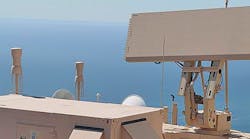The U.S. Air Force Advanced Radar Threat System Variant3 (ARTS-V3) system is extending its spectral reach into C-band with the latest advances from Lockheed Martin. The variable-aperture digital radar (VADR, see figure) now includes C-band technology along with its existing X-band frequency coverage for increased long-range adversarial threat coverage. The upgraded radar system adds to the detection capabilities of terrestrial surface-to-air-missile (SAM) radar defense systems.
The ARTS-V3 VADR system incorporates dual polarization capabilities and shares some electronic design with the Sentinel A4 radar system developed by Lockheed Martin. In addition to use by the U.S. Air Force, the C-band line-replaceable units (LRUs) can be employed by the U.S. Army and other military services within environments where commercial S-band electromagnetic (EM) interference is a concern.
By incorporating software-defined-radio (SDR) technology, the ARTS-V3 VADR system can process multiple threats within the X- and C-band frequency ranges rather than being limited to a single threat signal source, quickly adapting to changing threat environments. The system provides advanced early warning of threats and helps develop counter-target responses.
Learn more about radar:
About the Author
Jack Browne
Technical Contributor
Jack Browne, Technical Contributor, has worked in technical publishing for over 30 years. He managed the content and production of three technical journals while at the American Institute of Physics, including Medical Physics and the Journal of Vacuum Science & Technology. He has been a Publisher and Editor for Penton Media, started the firm’s Wireless Symposium & Exhibition trade show in 1993, and currently serves as Technical Contributor for that company's Microwaves & RF magazine. Browne, who holds a BS in Mathematics from City College of New York and BA degrees in English and Philosophy from Fordham University, is a member of the IEEE.




